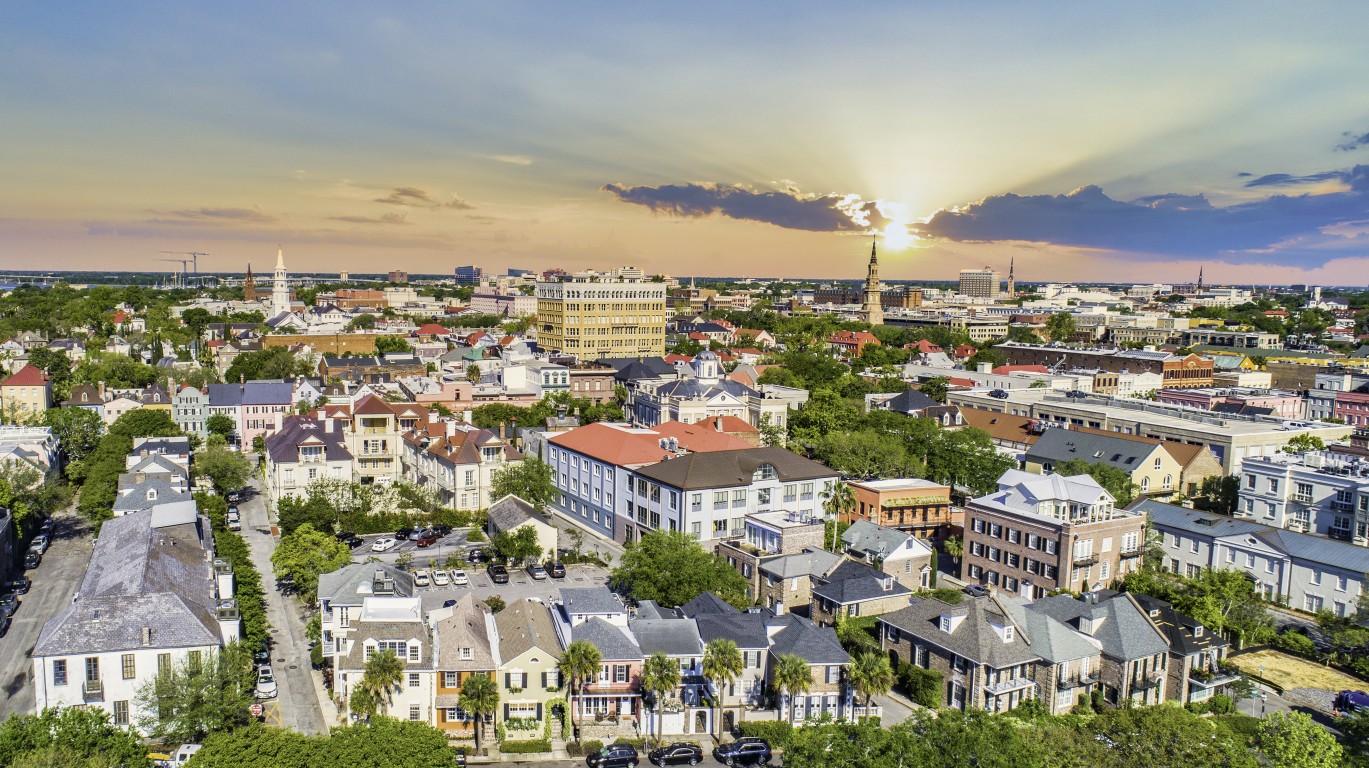
The New York Times recently reported a swath of Americans are leaving the U.S. for New Zealand in hopes of securing a less chaotic life. But for Americans looking to move a bit closer to home, relocating across state lines is on the rise. In 2021, about 7.9 million people moved out of their current state, compared to an uptick of 8.2 million people moving to a new state in 2022. These numbers highlight the ongoing decade-long trend of more Americans moving state-to-state, as opposed to relocating to other areas in their home state or leaving the country entirely. This remains the case, despite the fact that overall migration has declined.
The 24/7 Wall St. staff assessed the Census Bureau’s State Population Totals and Components of Change: 2020-2023, which was released at the end of 2023. They used this data to find which American state is shrinking the fastest. Specifically, they compared individual states’ July 1, 2023, population to its July 1, 2022, population. These states are listed in order of percentage change, from highest increase to largest decrease.
The three states with the least population decline are South Carolina, Florida, and Texas. Each of these states is located in the southern U.S., revealing a potential pattern of Americans favoring life in the South. However, other southern states like Louisiana top the list of population loss. The boot state lost 14,274 residents during the year in question.
New York State suffered the largest drop in population out of all 50 U.S. states, experiencing a 0.52% reduction in population. This is likely due in large part to a mass exodus from NYC. One recent survey found only 37.1% of residents were comfortable with the level of safety within the city.
Why We Are Writing About This

Though the number of Americans moving has decreased recently, thanks to reasons such as increased mortgage rates, plenty of Americans are still on the move. Recent research conducted by Architectural Digest found 29% of those surveyed have plans to relocate in 2024. Even more astounding: 39% of millennials wish to move, or have already done so, in 2024. Affordability was the most common reason for a potential move.
50. South Carolina

- Pct. population change, July 1, 2022 – July 1, 2023: 1.71%
- Total population change, July 1, 2022 – July 1, 2023: 90,600 — 5th largest absolute increase
- Population as of July 1, 2022: 5,282,955 — 23rd largest population
- Population as of July 1, 2023: 5,373,555 — 23rd largest population
49. Florida

- Pct. population change, July 1, 2022 – July 1, 2023: 1.64%
- Total population change, July 1, 2022 – July 1, 2023: 365,205 — 2nd largest absolute increase
- Population as of July 1, 2022: 22,245,521 — 3rd largest population
- Population as of July 1, 2023: 22,610,726 — 3rd largest population
48. Texas

- Pct. population change, July 1, 2022 – July 1, 2023: 1.58%
- Total population change, July 1, 2022 – July 1, 2023: 473,453 — the largest absolute increase
- Population as of July 1, 2022: 30,029,848 — 2nd largest population
- Population as of July 1, 2023: 30,503,301 — 2nd largest population
47. Idaho

- Pct. population change, July 1, 2022 – July 1, 2023: 1.33%
- Total population change, July 1, 2022 – July 1, 2023: 25,730 — 17th largest absolute increase
- Population as of July 1, 2022: 1,938,996 — 13th smallest population
- Population as of July 1, 2023: 1,964,726 — 13th smallest population
46. North Carolina

- Pct. population change, July 1, 2022 – July 1, 2023: 1.30%
- Total population change, July 1, 2022 – July 1, 2023: 139,526 — 3rd largest absolute increase
- Population as of July 1, 2022: 10,695,965 — 9th largest population
- Population as of July 1, 2023: 10,835,491 — 9th largest population
45. Delaware

- Pct. population change, July 1, 2022 – July 1, 2023: 1.22%
- Total population change, July 1, 2022 – July 1, 2023: 12,431 — 17th smallest absolute increase
- Population as of July 1, 2022: 1,019,459 — 6th smallest population
- Population as of July 1, 2023: 1,031,890 — 6th smallest population
44. Tennessee

- Pct. population change, July 1, 2022 – July 1, 2023: 1.10%
- Total population change, July 1, 2022 – July 1, 2023: 77,513 — 6th largest absolute increase
- Population as of July 1, 2022: 7,048,976 — 15th largest population
- Population as of July 1, 2023: 7,126,489 — 15th largest population
43. Utah

- Pct. population change, July 1, 2022 – July 1, 2023: 1.08%
- Total population change, July 1, 2022 – July 1, 2023: 36,498 — 10th largest absolute increase
- Population as of July 1, 2022: 3,381,236 — 21st smallest population
- Population as of July 1, 2023: 3,417,734 — 21st smallest population
42. Georgia

- Pct. population change, July 1, 2022 – July 1, 2023: 1.06%
- Total population change, July 1, 2022 – July 1, 2023: 116,077 — 4th largest absolute increase
- Population as of July 1, 2022: 10,913,150 — 8th largest population
- Population as of July 1, 2023: 11,029,227 — 8th largest population
41. South Dakota

- Pct. population change, July 1, 2022 – July 1, 2023: 1.04%
- Total population change, July 1, 2022 – July 1, 2023: 9,449 — 14th smallest absolute increase
- Population as of July 1, 2022: 909,869 — 5th smallest population
- Population as of July 1, 2023: 919,318 — 5th smallest population
40. Arizona

- Pct. population change, July 1, 2022 – July 1, 2023: 0.89%
- Total population change, July 1, 2022 – July 1, 2023: 65,660 — 7th largest absolute increase
- Population as of July 1, 2022: 7,365,684 — 14th largest population
- Population as of July 1, 2023: 7,431,344 — 14th largest population
39. Montana

- Pct. population change, July 1, 2022 – July 1, 2023: 0.88%
- Total population change, July 1, 2022 – July 1, 2023: 9,934 — 15th smallest absolute increase
- Population as of July 1, 2022: 1,122,878 — 8th smallest population
- Population as of July 1, 2023: 1,132,812 — 8th smallest population
38. Oklahoma

- Pct. population change, July 1, 2022 – July 1, 2023: 0.86%
- Total population change, July 1, 2022 – July 1, 2023: 34,553 — 12th largest absolute increase
- Population as of July 1, 2022: 4,019,271 — 23rd smallest population
- Population as of July 1, 2023: 4,053,824 — 23rd smallest population
37. Arkansas

- Pct. population change, July 1, 2022 – July 1, 2023: 0.70%
- Total population change, July 1, 2022 – July 1, 2023: 21,328 — 19th largest absolute increase
- Population as of July 1, 2022: 3,046,404 — 18th smallest population
- Population as of July 1, 2023: 3,067,732 — 18th smallest population
36. Alabama

- Pct. population change, July 1, 2022 – July 1, 2023: 0.68%
- Total population change, July 1, 2022 – July 1, 2023: 34,565 — 11th largest absolute increase
- Population as of July 1, 2022: 5,073,903 — 24th largest population
- Population as of July 1, 2023: 5,108,468 — 24th largest population
35. North Dakota

- Pct. population change, July 1, 2022 – July 1, 2023: 0.64%
- Total population change, July 1, 2022 – July 1, 2023: 5,014 — 10th smallest absolute increase
- Population as of July 1, 2022: 778,912 — 4th smallest population
- Population as of July 1, 2023: 783,926 — 4th smallest population
34. Colorado

- Pct. population change, July 1, 2022 – July 1, 2023: 0.63%
- Total population change, July 1, 2022 – July 1, 2023: 36,571 — 9th largest absolute increase
- Population as of July 1, 2022: 5,841,039 — 21st largest population
- Population as of July 1, 2023: 5,877,610 — 21st largest population
33. Nevada

- Pct. population change, July 1, 2022 – July 1, 2023: 0.53%
- Total population change, July 1, 2022 – July 1, 2023: 16,755 — 20th smallest absolute increase
- Population as of July 1, 2022: 3,177,421 — 19th smallest population
- Population as of July 1, 2023: 3,194,176 — 19th smallest population
32. Nebraska

- Pct. population change, July 1, 2022 – July 1, 2023: 0.52%
- Total population change, July 1, 2022 – July 1, 2023: 10,319 — 16th smallest absolute increase
- Population as of July 1, 2022: 1,968,060 — 14th smallest population
- Population as of July 1, 2023: 1,978,379 — 14th smallest population
31. Maine

- Pct. population change, July 1, 2022 – July 1, 2023: 0.46%
- Total population change, July 1, 2022 – July 1, 2023: 6,384 — 11th smallest absolute increase
- Population as of July 1, 2022: 1,389,338 — 9th smallest population
- Population as of July 1, 2023: 1,395,722 — 9th smallest population
30. Indiana

- Pct. population change, July 1, 2022 – July 1, 2023: 0.44%
- Total population change, July 1, 2022 – July 1, 2023: 29,925 — 14th largest absolute increase
- Population as of July 1, 2022: 6,832,274 — 17th largest population
- Population as of July 1, 2023: 6,862,199 — 17th largest population
29. Virginia

- Pct. population change, July 1, 2022 – July 1, 2023: 0.42%
- Total population change, July 1, 2022 – July 1, 2023: 36,599 — 8th largest absolute increase
- Population as of July 1, 2022: 8,679,099 — 12th largest population
- Population as of July 1, 2023: 8,715,698 — 12th largest population
28. Wyoming

- Pct. population change, July 1, 2022 – July 1, 2023: 0.42%
- Total population change, July 1, 2022 – July 1, 2023: 2,428 — 6th smallest absolute increase
- Population as of July 1, 2022: 581,629 — the smallest population
- Population as of July 1, 2023: 584,057 — the smallest population
27. Minnesota

- Pct. population change, July 1, 2022 – July 1, 2023: 0.41%
- Total population change, July 1, 2022 – July 1, 2023: 23,615 — 18th largest absolute increase
- Population as of July 1, 2022: 5,714,300 — 22nd largest population
- Population as of July 1, 2023: 5,737,915 — 22nd largest population
26. Washington

- Pct. population change, July 1, 2022 – July 1, 2023: 0.36%
- Total population change, July 1, 2022 – July 1, 2023: 28,403 — 15th largest absolute increase
- Population as of July 1, 2022: 7,784,477 — 13th largest population
- Population as of July 1, 2023: 7,812,880 — 13th largest population
25. Wisconsin

- Pct. population change, July 1, 2022 – July 1, 2023: 0.35%
- Total population change, July 1, 2022 – July 1, 2023: 20,412 — 20th largest absolute increase
- Population as of July 1, 2022: 5,890,543 — 20th largest population
- Population as of July 1, 2023: 5,910,955 — 20th largest population
24. New Jersey

- Pct. population change, July 1, 2022 – July 1, 2023: 0.32%
- Total population change, July 1, 2022 – July 1, 2023: 30,024 — 13th largest absolute increase
- Population as of July 1, 2022: 9,260,817 — 11th largest population
- Population as of July 1, 2023: 9,290,841 — 11th largest population
23. Kentucky

- Pct. population change, July 1, 2022 – July 1, 2023: 0.32%
- Total population change, July 1, 2022 – July 1, 2023: 14,591 — 18th smallest absolute increase
- Population as of July 1, 2022: 4,511,563 — 25th smallest population
- Population as of July 1, 2023: 4,526,154 — 25th smallest population
22. Missouri

- Pct. population change, July 1, 2022 – July 1, 2023: 0.31%
- Total population change, July 1, 2022 – July 1, 2023: 18,988 — 21st largest absolute increase
- Population as of July 1, 2022: 6,177,168 — 18th largest population
- Population as of July 1, 2023: 6,196,156 — 18th largest population
21. Massachusetts

- Pct. population change, July 1, 2022 – July 1, 2023: 0.27%
- Total population change, July 1, 2022 – July 1, 2023: 18,659 — 21st smallest absolute increase
- Population as of July 1, 2022: 6,982,740 — 16th largest population
- Population as of July 1, 2023: 7,001,399 — 16th largest population
20. Maryland

- Pct. population change, July 1, 2022 – July 1, 2023: 0.26%
- Total population change, July 1, 2022 – July 1, 2023: 16,272 — 19th smallest absolute increase
- Population as of July 1, 2022: 6,163,981 — 19th largest population
- Population as of July 1, 2023: 6,180,253 — 19th largest population
19. Connecticut

- Pct. population change, July 1, 2022 – July 1, 2023: 0.23%
- Total population change, July 1, 2022 – July 1, 2023: 8,470 — 13th smallest absolute increase
- Population as of July 1, 2022: 3,608,706 — 22nd smallest population
- Population as of July 1, 2023: 3,617,176 — 22nd smallest population
18. Iowa

- Pct. population change, July 1, 2022 – July 1, 2023: 0.23%
- Total population change, July 1, 2022 – July 1, 2023: 7,311 — 12th smallest absolute increase
- Population as of July 1, 2022: 3,199,693 — 20th smallest population
- Population as of July 1, 2023: 3,207,004 — 20th smallest population
17. Ohio

- Pct. population change, July 1, 2022 – July 1, 2023: 0.22%
- Total population change, July 1, 2022 – July 1, 2023: 26,238 — 16th largest absolute increase
- Population as of July 1, 2022: 11,759,697 — 7th largest population
- Population as of July 1, 2023: 11,785,935 — 7th largest population
16. New Hampshire

- Pct. population change, July 1, 2022 – July 1, 2023: 0.22%
- Total population change, July 1, 2022 – July 1, 2023: 3,051 — 7th smallest absolute increase
- Population as of July 1, 2022: 1,399,003 — 10th smallest population
- Population as of July 1, 2023: 1,402,054 — 10th smallest population
15. Rhode Island

- Pct. population change, July 1, 2022 – July 1, 2023: 0.19%
- Total population change, July 1, 2022 – July 1, 2023: 2,120 — 5th smallest absolute increase
- Population as of July 1, 2022: 1,093,842 — 7th smallest population
- Population as of July 1, 2023: 1,095,962 — 7th smallest population
14. Kansas

- Pct. population change, July 1, 2022 – July 1, 2023: 0.13%
- Total population change, July 1, 2022 – July 1, 2023: 3,830 — 8th smallest absolute increase
- Population as of July 1, 2022: 2,936,716 — 16th smallest population
- Population as of July 1, 2023: 2,940,546 — 17th smallest population
13. Vermont

- Pct. population change, July 1, 2022 – July 1, 2023: 0.05%
- Total population change, July 1, 2022 – July 1, 2023: 354 — 2nd smallest absolute increase
- Population as of July 1, 2022: 647,110 — 2nd smallest population
- Population as of July 1, 2023: 647,464 — 2nd smallest population
12. New Mexico

- Pct. population change, July 1, 2022 – July 1, 2023: 0.04%
- Total population change, July 1, 2022 – July 1, 2023: 895 — 4th smallest absolute increase
- Population as of July 1, 2022: 2,113,476 — 15th smallest population
- Population as of July 1, 2023: 2,114,371 — 15th smallest population
11. Michigan

- Pct. population change, July 1, 2022 – July 1, 2023: 0.04%
- Total population change, July 1, 2022 – July 1, 2023: 3,980 — 9th smallest absolute increase
- Population as of July 1, 2022: 10,033,281 — 10th largest population
- Population as of July 1, 2023: 10,037,261 — 10th largest population
10. Mississippi

- Pct. population change, July 1, 2022 – July 1, 2023: 0.03%
- Total population change, July 1, 2022 – July 1, 2023: 762 — 3rd smallest absolute increase
- Population as of July 1, 2022: 2,938,928 — 17th smallest population
- Population as of July 1, 2023: 2,939,690 — 16th smallest population
9. Alaska

- Pct. population change, July 1, 2022 – July 1, 2023: 0.02%
- Total population change, July 1, 2022 – July 1, 2023: 130 — the smallest absolute increase
- Population as of July 1, 2022: 733,276 — 3rd smallest population
- Population as of July 1, 2023: 733,406 — 3rd smallest population
8. Pennsylvania

- Pct. population change, July 1, 2022 – July 1, 2023: -0.08%
- Total population change, July 1, 2022 – July 1, 2023: -10,408 — 4th smallest absolute decline
- Population as of July 1, 2022: 12,972,091 — 5th largest population
- Population as of July 1, 2023: 12,961,683 — 5th largest population
7. Oregon

- Pct. population change, July 1, 2022 – July 1, 2023: -0.14%
- Total population change, July 1, 2022 – July 1, 2023: -6,021 — 3rd smallest absolute decline
- Population as of July 1, 2022: 4,239,379 — 24th smallest population
- Population as of July 1, 2023: 4,233,358 — 24th smallest population
6. California

- Pct. population change, July 1, 2022 – July 1, 2023: -0.19%
- Total population change, July 1, 2022 – July 1, 2023: -75,423 — 2nd largest absolute decline
- Population as of July 1, 2022: 39,040,616 — the largest population
- Population as of July 1, 2023: 38,965,193 — the largest population
5. West Virginia

- Pct. population change, July 1, 2022 – July 1, 2023: -0.22%
- Total population change, July 1, 2022 – July 1, 2023: -3,964 — the smallest absolute decline
- Population as of July 1, 2022: 1,774,035 — 12th smallest population
- Population as of July 1, 2023: 1,770,071 — 12th smallest population
4. Illinois

- Pct. population change, July 1, 2022 – July 1, 2023: -0.26%
- Total population change, July 1, 2022 – July 1, 2023: -32,826 — 3rd largest absolute decline
- Population as of July 1, 2022: 12,582,515 — 6th largest population
- Population as of July 1, 2023: 12,549,689 — 6th largest population
3. Hawaii

- Pct. population change, July 1, 2022 – July 1, 2023: -0.30%
- Total population change, July 1, 2022 – July 1, 2023: -4,261 — 2nd smallest absolute decline
- Population as of July 1, 2022: 1,439,399 — 11th smallest population
- Population as of July 1, 2023: 1,435,138 — 11th smallest population
2. Louisiana

- Pct. population change, July 1, 2022 – July 1, 2023: -0.31%
- Total population change, July 1, 2022 – July 1, 2023: -14,274 — 4th largest absolute decline
- Population as of July 1, 2022: 4,588,023 — 25th largest population
- Population as of July 1, 2023: 4,573,749 — 25th largest population
1. New York

- Pct. population change, July 1, 2022 – July 1, 2023: -0.52%
- Total population change, July 1, 2022 – July 1, 2023: -101,984 — the largest absolute decline
- Population as of July 1, 2022: 19,673,200 — 4th largest population
- Population as of July 1, 2023: 19,571,216 — 4th largest population
Want to Retire Early? Start Here (Sponsor)
Want retirement to come a few years earlier than you’d planned? Or are you ready to retire now, but want an extra set of eyes on your finances?
Now you can speak with up to 3 financial experts in your area for FREE. By simply clicking here you can begin to match with financial professionals who can help you build your plan to retire early. And the best part? The first conversation with them is free.
Click here to match with up to 3 financial pros who would be excited to help you make financial decisions.
Have questions about retirement or personal finance? Email us at [email protected]!
By emailing your questions to 24/7 Wall St., you agree to have them published anonymously on a673b.bigscoots-temp.com.
By submitting your story, you understand and agree that we may use your story, or versions of it, in all media and platforms, including via third parties.
Thank you for reading! Have some feedback for us?
Contact the 24/7 Wall St. editorial team.